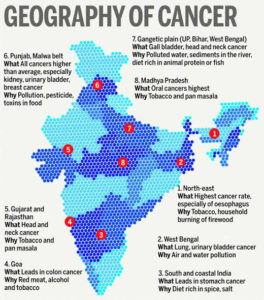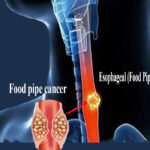

Poor lifestyle habits have aided the prevalence of cancer among Indians and higher incidences of cancer cases reported in women than men. Increasing awareness can make India cancer-free.A lifestyle which involves excessive smoking and drinking, lack of physical exercise (leading to obesity and hormone imbalance) and a poor diet is the culprit for the rising number of cancer cases. World Health Organization’s (WHO) International Agency for Research on cancer stated that cancer will claim 9.6 million lives in the world this year. India will account for 8.17 per cent of the same. Another report by the Lancet reinforced the same saying cancer is India’s second biggest killer after heart disease.
Adopting good lifestyle practices to prevent non-communicable diseases, particularly cancer is the need of the hour. It is necessary to ensure and have a balanced diet and engage in regular physical activity. Most diets are marred with preservatives and added flavours. A lot of hidden carcinogens are entering human bodies. Tobacco consumption, alcohol intake and substance abuse has increased, leaving the body weak and the immune system vulnerable. Lung cancer is also occurring in people who have never smoked as well. Statistics reveal that 15% of patients diagnosed with lung cancer have no history of tobacco use. This could be because of exposure to second hand smoke, asbestos exposure, air pollution (outdoor and indoor), and exposure to radon gas, diesel exhaust fumes or a genetic predisposition.
There are two prominent trends that have been observed in the last year. Firstly, breast cancer incidence has gone up by 39.1% over the last decade, making it the most prevalent type of cancer. The second trend indicates a high rate of re – occurrence or dual occurrence of cancer. A survivor’s risk of getting a new cancer diagnosis is 14% greater than someone who never had cancer. This is a worrying fact but to counter it, we need to create awareness about regular check-ups and counselling even after one is completely cured.


There is no increase of incidence from 2018-2019. However population explosion and pollution increase, exposure to carcinogens may increase the number and incidence of the diseases. Early detection can also contribute. In males oral cancer, lung cancer, prostate and Gastro-Intestinal (GI) cancers can be seen as early as the age of 25 years. In females breast cancer, cervix cancer, ovarian and uterine cancer and oral cancers are common from age 35 onwards. Lifestyle factor contributions are tobacco and alcohol, junk food, stress and lack of exercise. India accounts for high number of oral cancer amongst young due to tobacco, alcohol. 30-35% cases are in this group. Similarly lung cancer incidence is high due to smoking habits. It is diagnosed late due to use of antibiotics and anti-tubercular treatment for chest symptoms. Northern India has incidence of gallbladder cancer due to proximity of sub Himalaya Ganges. Gall stones are also contributory. Pollutants in water is one of causes.
Lung and breast cancer are leading worldwide with approximately 2.1 million diagnoses estimated in 2018. Colorectal cancer (1.8 million cases, 10.2% of the total) is the third most commonly diagnosed cancer, prostate cancer is the fourth (1.3 million cases, 7.1%). Cancer is a generic term for a large group of diseases that can affect any part of the body. Other terms used are malignant tumours and neoplasms. The defining feature of cancer is the rapid creation of abnormal cells that grow beyond their usual boundaries. Between 30–50% of cancers can currently be prevented. This can be accomplished by avoiding risk factors and implementing existing evidence-based prevention strategies.


Dr Kapil Kumar
MBBS, MS, FICS
Director and HOD, Surgical Oncology
Fortis Hospital, Shalimar Bagh
New Delhi -110088
Ph: 011 4530 2222


Dr Mandeep S Malhotra
MBBS, MS Head- Breast
Fortis Flt. Lt. Rajan Dhall Hospital, Vasant Kunj











